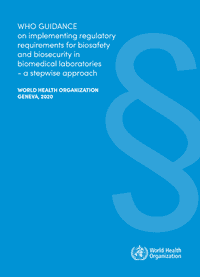WHO Guidance on Implementing Regulatory Requirements for Biosafety and Biosecurity in Biomedical Laboratories: a Stepwise Approach
[WHO Guidance on Biosafety and Biosecurity Regulatory Requirements]
This document is intended to provide practical information and guidelines for policy-makers and national regulatory bodies as they develop and strengthen national biosafety and biosecurity regulatory frameworks. It includes a seven-step plan for developing and implementing laboratory biosafety and biosecurity regulations.
SUMMARY
This document provides recommendations for the components of a comprehensive, integrated, and effective regulatory framework for biosafety and biosecurity. These recommendations are primarily aimed at regulators within WHO Member States that have relatively weak biosafety and biosecurity regulatory systems and few regulations for biomedical laboratories. However, this guidance may also be helpful for regulators seeking practical guidelines for strengthening existing national regulatory frameworks. This document includes a seven-step plan for developing and implementing laboratory biosafety and biosecurity regulations. It also includes a high-level review of existing regulations in selected WHO Member States (see Section 2 and Annex II) and a questionnaire tool for assessing existing controls in biomedical laboratories (see Annex III: Section B).
This guidance document is the result of a joint effort by the World Health Organization (WHO) and the University of Applied Sciences Lübeck, Germany. The WHO is the agency of the United Nations responsible for international public health. The agency has 194 member states, and its mission is to promote the right to health and well-being for all people, as stipulated in its 1948 constitution. The WHO also leads and coordinates the international response to health emergencies. To create the first draft of the document, staff at the WHO and the University of Applied Sciences Lübeck, Germany conducted a review of existing biosafety and biosecurity regulatory structures in a diverse set of countries. The first draft of the document was then circulated, reviewed, and discussed with stakeholders from the Democratic Republic of Ethiopia before being revised and reviewed at the WHO headquarters in Geneva with representatives from WHO Member States, WHO Regional Offices, and several other international organizations.


..png)
